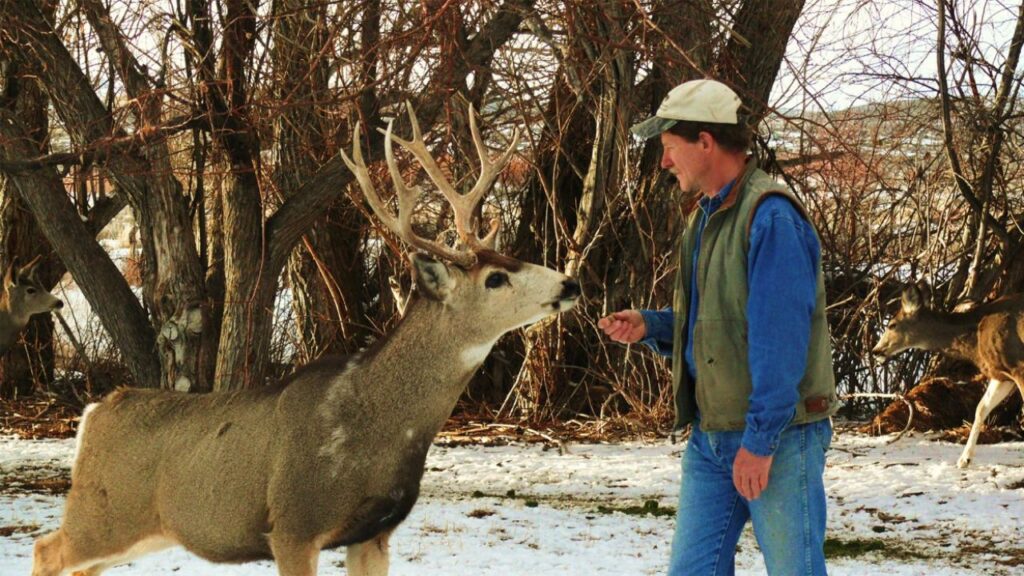Do Deer Attack Humans? Deer attacks on humans are rare but can occur, particularly during mating season when males are more aggressive or when a mother is protecting her young.
Deer are a common sight in many parts of the world, often admired for their grace and beauty.
However, as human populations expand into deer habitats, encounters between humans and deer have become more frequent.
Understanding deer behavior, especially during certain times of the year, can help prevent dangerous encounters and ensure both human and deer safety.
Contents
Who is the Deer?
General Characteristics
Deer belong to the family Cervidae and include species such as white-tailed deer, mule deer, elk, and moose.
These herbivorous animals are known for their slender bodies, long legs, and, in males, the presence of antlers. Antlers are used by males during mating season to compete for females.
Physical Features
Deer have a well-adapted physique for their environment. Their long legs enable them to run at high speeds, an essential trait for escaping predators.
Antlers, found primarily on males, are shed and regrown annually and can be used both for defense and establishing dominance during the rutting season.
Their acute senses of smell, hearing, and vision aid in detecting predators and foraging for food. [Do Deer Attack Humans?]
Behavior and Habitat
Deer are typically crepuscular, meaning they are most active during dawn and dusk. They inhabit a variety of environments, including forests, grasslands, and wetlands.
Deer are also highly adaptable and often live near human settlements where food is plentiful.
Social Structure
Deer generally live in groups known as herds, which can vary in size depending on the species and environment. These herds are typically matriarchal, led by an older doe.
Bucks tend to be solitary or form small bachelor groups outside of the mating season. The social structure plays a significant role in their behavior, especially during mating and fawning seasons.
Diet and Foraging
Deer are herbivores and have a diverse diet that includes leaves, twigs, fruits, and nuts.
Seasonal changes significantly impact their feeding habits; for instance, in the spring and summer, they feed on green vegetation, while in the fall and winter, their diet shifts to woody plants and fallen leaves.
Their foraging behavior can sometimes lead them into human gardens and agricultural areas, causing conflicts.

When and Why Do Deer Attack Humans?
During Mating Season (The Rut)
The rut is the mating season for deer, occurring primarily in the fall. During this time, male deer, or bucks, experience a surge in testosterone, which makes them more aggressive and territorial.
Bucks may fight with each other for access to females and can mistakenly perceive humans as rivals.
Behavioral Changes in Bucks
- Bucks exhibit increased aggression and territorial behavior.
- They may challenge humans by displaying their antlers, stomping, and snorting.
- Attacks are more likely if bucks feel their dominance is threatened.
During the rut, bucks are highly competitive and can become unpredictable. Their heightened aggression is a natural response to the need to establish dominance and secure mating opportunities.
Human activities, such as hiking or camping in areas with high deer populations during this time, can inadvertently provoke these animals.
Protecting Their Young (Fawning Season)
In the spring, female deer, or does, give birth to fawns. During this period, does are extremely protective of their offspring.
If a human gets too close to a fawn, the mother may perceive this as a threat and act aggressively to protect her young.
Defensive Behavior in Does
- Does may charge, stomp, or kick to ward off perceived threats.
- Protective instincts are heightened during the fawning season.
- Approaching a fawn can provoke a defensive response from the mother.
Does are particularly vigilant during the first few weeks of a fawn’s life when the young are most vulnerable.
They often leave their fawns hidden while they forage, returning periodically to nurse and protect them. [Do Deer Attack Humans?]
Encountering a seemingly abandoned fawn can lead to dangerous misunderstandings if the mother is nearby and perceives a threat.
When Cornered or Threatened
Like many wild animals, deer prefer to flee from danger. However, if they feel cornered or unable to escape, they may attack to defend themselves.
This can occur if a deer is surprised, trapped, or feels that there is no other option. [Do Deer Attack Humans?]
Defensive Aggression
- Deer may rear up on their hind legs and strike with their front hooves.
- Bucks may use their antlers to gore or push away threats.
- Deer can become aggressive if they feel there is no escape route.
In scenarios where a deer feels trapped or cornered, their natural flight response is overridden by the need to defend themselves.
This defensive aggression can be triggered by close encounters with humans, especially in confined spaces or when surprised.
Understanding these triggers can help in avoiding dangerous situations. [Do Deer Attack Humans?]

Signs of Aggressive Deer Behavior
Recognizing the signs of aggression in deer can help you avoid an attack. Deer may display several warning signals before becoming physically aggressive.
Physical and Behavioral Indicators
- Rigid Posture: The deer stands tall and stiff, indicating alertness and readiness to fight.
- Stomping or Kicking Hooves: A sign of agitation and a warning to back off.
- Flattened Ears: Ears laid back against the head indicate aggression.
- Intense Stare: The deer focuses intently on the perceived threat. [Do Deer Attack Humans?]
- Lowered Head and Antlers: Bucks may lower their heads and point their antlers towards the threat, preparing to charge.
Understanding these signs can be crucial in preventing an attack. [Do Deer Attack Humans?]
If a deer displays any of these behaviors, it is best to slowly and calmly back away, avoiding sudden movements that might provoke further aggression.
How to Avoid Deer Attacks
Safety Tips
Preventing deer attacks involves understanding their behavior and taking precautions, especially during the rut and fawning seasons.
- Avoid Deer During High-Risk Seasons: Stay away from deer during the rut (fall) and fawning season (spring).
- Keep a Safe Distance: Do not approach deer, especially if they are showing signs of aggression.
- Stick to Trails: When hiking or camping, stick to marked trails to avoid surprising deer.
- Keep Pets Leashed: Dogs can provoke deer, leading to aggressive behavior.
- Do Not Feed Deer: Feeding deer can reduce their natural fear of humans and lead to aggressive encounters.
Precautions During High-Risk Seasons
- During the Rut: Avoid hiking or camping in areas with high deer populations during the rut. If you must be in these areas, stay on well-used trails and avoid wandering off the path.
- During Fawning Season: Be particularly cautious in spring, as does are very protective of their fawns. Keep an eye out for fawns and avoid approaching them.
Home Safety Measures
- Fencing: Install deer-proof fencing around gardens and yards to prevent deer from entering.
- Repellents: Use deer repellents that can deter deer from coming close to residential areas.
- Motion-Activated Devices: Employ motion-activated lights or sprinklers to scare deer away.
What to Do If a Deer Attacks
Immediate Actions
If you find yourself in a situation where a deer is about to attack, it is crucial to know how to protect yourself.
- Stay Calm and Back Away Slowly: Avoid sudden movements that could provoke the deer further.
- Make Yourself Appear Larger: Raise your arms and make loud noises to intimidate the deer.
- Find a Barrier: Use trees, rocks, or other large objects to shield yourself.
- Curl into a Fetal Position: If knocked to the ground, protect your head and vital organs by curling up tightly.
Defensive Tactics
- Use Objects as Shields: If available, use backpacks, jackets, or other objects to shield yourself from the deer’s blows.
- Fight Back if Necessary: In extreme cases where the deer continues to attack, use any available objects to defend yourself.
Seeking Medical Attention
Even minor injuries from deer attacks can become serious if left untreated. Seek immediate medical attention if you are injured.
Wounds from deer antlers or hooves can become infected, as these can lead to infections or complications. [Do Deer Attack Humans?]
Medical professionals can ensure proper cleaning and treatment of wounds, reducing the risk of further issues.
Long-Term Considerations
- Report the Incident: Notify local wildlife authorities about aggressive deer behavior, especially if it occurred in a public area.
- Follow-Up Care: Monitor wounds for signs of infection and follow up with healthcare providers if necessary.
See Also: Do Cheetahs Attack Humans? The Untold Truth!
Frequently Asked Questions (FAQs)
Q: How common are deer attacks on humans?
A: Deer attacks on humans are rare but can occur, particularly during mating and fawning seasons. Most deer prefer to avoid humans, but certain circumstances can provoke aggressive behavior.
Q: What should I do if I see a fawn alone?
A: Do not approach the fawn. The mother is likely nearby and may become aggressive if she perceives you as a threat. It’s best to leave the fawn alone and avoid the area.
Q: Can deer attacks be fatal?
A: While rare, deer attacks can cause serious injuries and, in very rare cases, can be fatal. Most fatalities occur due to severe trauma from antlers or hooves.
Q: Are certain deer species more aggressive than others?
A: Aggression can occur in any deer species, but white-tailed deer and mule deer are commonly involved in attacks due to their widespread presence in North America. However, all deer species can exhibit aggressive behavior under certain conditions.
Q: How can I deter deer from my property?
A: Use deer repellents, fencing, and motion-activated lights to keep deer away from your yard. Planting deer-resistant plants and removing attractants like food and water sources can also help deter deer.
Q: What time of year are deer most aggressive?
A: Deer are most aggressive during the rutting season in the fall and the fawning season in the spring. These periods correspond to increased territoriality and protective behavior, respectively.
Conclusion: Do Deer Attack Humans?
Deer are fascinating and usually peaceful animals, but under certain conditions, they can become aggressive.
By understanding deer behavior, particularly during mating and fawning seasons, and taking appropriate precautions, you can minimize the risk of a dangerous encounter.
Always respect wildlife and maintain a safe distance to ensure both your safety and the well-being of the deer.
Understanding and respecting deer behavior is key to coexisting safely with these beautiful creatures. By being aware of the potential risks and knowing how to respond, you can enjoy nature while staying safe.
Coexisting with deer involves respecting their space and natural behaviors, ensuring a harmonious relationship between humans and these majestic animals.

Hello, I am Rosa Ellis, a mother of two and a wildlife blogger. I grew up in New York City, but I love exploring forests. I’ve traveled to places like Yellowstone National Park and the Amazon Rainforest to see animals up close. I know a lot about animal behavior and which animals can be dangerous to humans. Thanks for visiting my blog!

